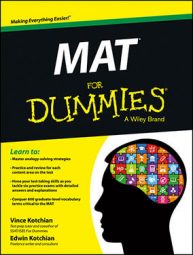The Miller Analogies Test (MAT) is a standardized test normally used for graduate school admissions. The test is composed entirely of analogies. To do well on the MAT, it helps to understand that its analogies fall into several different categories.
MAT analogies are all about relationships, and familiarizing yourself with some of the general categories of relationships on the MAT can make it easier to identify them in questions.
The MAT officially lists four types of relationships: Semantic, Classification, Association, and Logical/Mathematical. The names for these types are not as simple and descriptive as they could be, so it helps to group the MAT analogies into these five major categories:
Description
Type
Parts
Similar/different
Playful
For example, in parts analogies, one term is often part of another term, or both related terms are parts of something else. Here’s an example of a parts analogy:
CENTIMETER : METER :: OUNCE : _________________
(A)pound
(B)liquid
(C)weight
(D)unit
This is another 1:2,3:4 analogy, and the correct answer is Choice (A). A centimeter is part of a meter, as an ounce is part of a pound. Notice that it’s handy to use the phrase “part of” to think about the relationship between the related terms.
The relationship direction of the analogy can be reversed by writing it like this:
METER : CENTIMETER :: _________________ : OUNCE
(A)pound
(B)liquid
(C)weight
(D)unit
It’s still a 1:2,3:4 analogy and it’s still a parts analogy — the only thing that’s changed is that the second term is now part of the first term, as the fourth term is part of the third term. (A centimeter is part of a meter, as an ounce is part of a pound.) The answer is still Choice (A) (pound).
Here’s another parts analogy example:
SOUTH : DAKOTA :: _________________ : VIRGINIA
(A)colonial
(B)coastal
(C)state
(D)west
In this example, the first and second choices (South and Dakota) are both parts of a whole (the state South Dakota), as the third and fourth choices are both parts of a whole (using Choice [D], they combine to form West Virginia). It’s a 1:2,3:4 structure. Again, you can think of it in terms of parts; this time, the parts both combine to create a whole.

